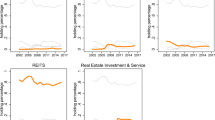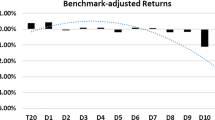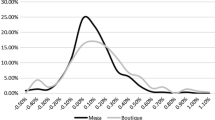Abstract
Real estate private equity (REPE) funds are often differentiated by risk class: Core, Value-Added, or Opportunistic. Fund class is used by investors and managers to allocate funds and to describe investment policies. In this paper, we use REPE fund cash flow data from Burgiss that allow us to calculate a variety of performance metrics. For a subset of the data, we also observe characteristics of underlying fund holdings. Despite evidence that Value-Added and Opportunistic funds differ in investment composition, we show that class does not do a good job of predicting differences in performance. Unsurprisingly, greater investment in development (as assessed ex post), predicts poor performance for funds raised just before the Great Recession.







Similar content being viewed by others
Notes
Detailed data on leverage is difficult to capture, and at this time, unavailable.
Burgiss retains information about resolved funds such that we do not lose information about the performance of completed funds and the sample does not suffer from survivorship bias.
A comparison between Burgiss and Preqin is made in Fisher and Hartzell (2013).
By virtue of the fact that these funds are resolved, they tend be from older vintages. Therefore, these duration statistics may not capture more recent trends.
Since the end of 2009, GPs are required to update NAV to “fair value” on a quarterly basis as a result of Topic 820 of the Financial Accounting Standards Board. While estimating the “fair value” of a property that is under development or undergoing a management or leasing turnaround is difficult, older funds are more likely to have distributed the majority of their value thus minimizing this source of bias in estimates of performance.
Calculation of time-weighted holding period returns would provide additional insight into the performance of real estate private equity funds, as well as performance relative to widely-used private real estate indices. Because net asset values for the funds in our sample are only available as of Q42013 for non-realized funds, or as of the date of final distribution of cash flows to investors for realized funds, we are not able to make these calculations at this time.
We use the value-weighted returns series.
We use the North American index as the index for any fund not focused on Asia or Europe.
Because data from EPRA does not start until 1990, the EPRA AMEs excluded vintages from the 1980s.
The sole exception is with respect to the equity multiple in which case Value-Added multiples are larger on average than Opportunistic multiples in the pre-2004 vintage group.
For property types, we are able to use sub-indexes for residential, hotel and resort, industrial, office and retail in creating a “tailored” index. We use the overall REIT or EPRA index in proportion to the weight of any residual property type in fund portfolios.
As in Ling and Naranjo (2014), we calculate this average as 96 basis points per year or 24 basis points quarterly based on the equally-weighted ODCE data.
We only include the EPRA AME, and not the REIT AME, because we think this is the preferred benchmark for our international set of funds.
References
Alcock, J., Baum, A., Colley, N., Steiner, E. M. (2013). The role of financial leverage in the performance of private equity real estate funds. Journal of Portfolio Management, 39(5), 99–110.
Andonov, A., Eichholtz, P., & Kok, N. (2012). Value added from money managers in private markets? An examination of pension fund investments in real estate. Working paper.
Baum, A. E., & Hartzell, D. (2012). Global property investment: strategies, structures, decisions. West Sussex, UK: Wiley-Blackwell.
Bond, S. A., & Mitchell, P. (2010). Alpha and persistence in real estate fund performance. Journal of Real Estate Finance and Economics, 41, 53–79.
Boudry, W. I., Coulson, N. E., Kallberg, J. G., & Liu, C. H. (2012). On the hybrid nature of REITs. Journal of Real Estate Finance and Economics, 44, 230–249.
Fisher, L. M., & Hartzell, D. (2013). Real estate private equity performance: a new look. Working Paper: http://areas.kenan-flagler.unc.edu/finance/PERC/REPE%20Performance%20July%202013%20v3.pdf.
Hahn, T. C., Geltner, D., & Lietz, N. G. (2005). Real estate opportunity funds. The Journal of Portfolio Management, 31(5), 143–153.
Harris, R. S., Jenkinson, T., & Kaplan, S. N. (2014). Private equity performance: what do we know? Journal of Finance, 69(5), 1851–1882.
Jenkinson, T., Sousa, M., & Stucke, R. (2013). How fair are valuations of private equity funds? Working Paper.
Kaplan, S. N., & Schoar, A. (2005). Private equity performance: returns, persistence and capital flows. The Journal of Finance, 60(4), 1791–1823.
Ling, D. C., & Naranjo, A. (2014). Returns and information transmission dynamics in public and private real estate markets. Real Estate Economics, forthcoming.
Tomperi, I. (2010). Performance of private equity real estate funds. Journal of European Real Estate Research, 3(2), 96–116.
Acknowledgments
The authors are grateful to Burgiss for supplying the data for this study and for providing their insights into the industry. We also thank the Private Equity Research Consortium (PERC) and the UAI Foundation for support. Helpful comments were provided by Paul Mehlman, Ira Shaw, Barry Griffiths, Shaun Bond and an anonymous referee.
Author information
Authors and Affiliations
Corresponding author
Rights and permissions
About this article
Cite this article
Fisher, L.M., Hartzell, D.J. Class Differences in Real Estate Private Equity Fund Performance. J Real Estate Finan Econ 52, 327–346 (2016). https://doi.org/10.1007/s11146-015-9526-z
Published:
Issue Date:
DOI: https://doi.org/10.1007/s11146-015-9526-z




